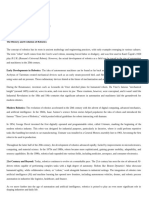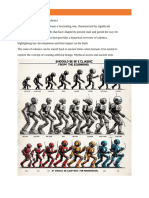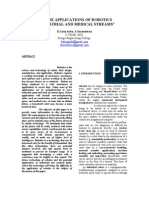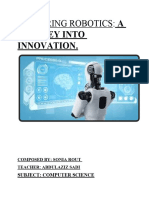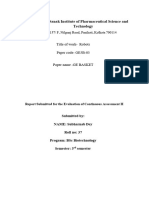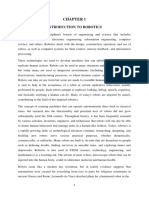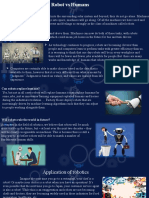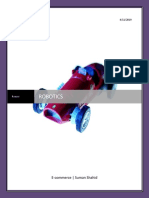0 ratings0% found this document useful (0 votes)
3 viewsLecture 1
A robot is a programmable machine capable of performing tasks autonomously or with human guidance, utilizing sensors and actuators. The history of robotics spans from ancient automatons to modern advancements, with key milestones including the development of industrial robots and autonomous vehicles. Robotics has diverse applications across industries such as manufacturing, healthcare, and agriculture, and its integration with artificial intelligence enhances capabilities and efficiency.
Uploaded by
M Ahtisham MunirCopyright
© © All Rights Reserved
Available Formats
Download as PDF, TXT or read online on Scribd
0 ratings0% found this document useful (0 votes)
3 viewsLecture 1
A robot is a programmable machine capable of performing tasks autonomously or with human guidance, utilizing sensors and actuators. The history of robotics spans from ancient automatons to modern advancements, with key milestones including the development of industrial robots and autonomous vehicles. Robotics has diverse applications across industries such as manufacturing, healthcare, and agriculture, and its integration with artificial intelligence enhances capabilities and efficiency.
Uploaded by
M Ahtisham MunirCopyright
© © All Rights Reserved
Available Formats
Download as PDF, TXT or read online on Scribd
You are on page 1/ 5
What is Robot?
A robot is a programmable machine designed to perform tasks autonomously or with human
guidance. Robots can be equipped with sensors, actuators, and other devices to interact with their
environment and carry out specific functions. They can range from simple devices, such as
industrial robotic arms, to more complex systems with artificial intelligence and advanced mobility
capabilities.
The development of robotics has been driven by the need for automated systems that can perform
tasks without human intervention, as well as by the desire to replicate the abilities and intelligence
of the human mind. This has led to the creation of a wide variety of robots, from simple machines
that can perform repetitive tasks to highly advanced robots that can think and learn.
History of Robotics
The history of robotics can be traced back to ancient times, with the creation of simple machines
and automatons that were designed to perform specific tasks. However, the modern concept of
robotics, as we know it today, began to take shape in the 20th century. Some key milestones in the
history of robotics include:
1. 1951: George Devol patents the first digitally-operated programmable robot, which he called
the “Unimate.” This robot was later used in manufacturing to perform tasks such as welding
and assembly.
2. 1968: The first robot to work in a factory environment, the Stanford Arm, was built by Victor
Scheinman at the Stanford Artificial Intelligence Laboratory (SAIL).
3. 1974: The first industrial robot, named “IRB 6,” was created by Asea Brown Boveri (ABB).
4. 1980: The first robot to be used in surgery was the PUMA 560, which was developed by
Computer Motion.
5. 1983: The first autonomous mobile robot, named “Genghis,” was developed by the
Massachusetts Institute of Technology (MIT).
6. 1986: NASA’s Mars rover, Sojourner, was the first robot to be sent to another planet.
7. 2000: The first robot to compete in the DARPA Grand Challenge, a competition for
autonomous vehicles, was the “Sandstorm” built by a team from the Red Team of Carnegie
Mellon University.
8. 2014: Amazon introduces a robot, “Kiva” for inventory management in their warehouse.
9. 2019: Boston Dynamics released the first commercial robot, SpotMini, which is designed for
use in a variety of settings, including construction, emergency response, and security.
Today, robotics technology continues to evolve and advance, with new applications and uses being
developed in fields such as healthcare, agriculture, transportation, and more.
Here are some common types of robots based on their applications and functions:
Types of Robotics
1. Industrial robotics: Industrial robots are used in manufacturing, assembly, and other
industrial processes. They are typically large, highly precise machines that are programmed to
perform specific tasks such as welding, painting, and packaging. They are used to improve
efficiency, reduce costs, and improve the quality of products.
2. Service robotics: Service robots are used in domestic and personal settings, such as
vacuuming robots and personal assistants. They are designed to assist people with everyday
tasks, such as cleaning, cooking, and providing information. They are also used in healthcare
and elderly care facilities to assist with tasks such as lifting and moving patients.
3. Medical robotics: Medical robots are used in surgeries and other medical procedures. They
are designed to assist surgeons in performing complex procedures with increased precision and
accuracy. They are also used in rehabilitation, physical therapy, and other medical applications.
4. Military robotics: Military robots are used in military operations, such as bomb disposal and
surveillance. They are designed to perform tasks that are too dangerous for humans, such as
defusing bombs and entering buildings. They are also used for reconnaissance, surveillance,
and target acquisition.
5. Space robotics: Space robots are used in space exploration and satellite maintenance. They
are designed to operate in the harsh conditions of space and are used to repair and maintain
satellites, explore other planets, and perform other tasks.
6. Agricultural robotics: Agricultural robots are used to automate tasks in agriculture. They are
used for tasks such as planting, harvesting, and monitoring crops. They can also be used for
tasks such as soil analysis, crop spraying, and precision farming.
7. Search and Rescue Robotics: Search and Rescue robots are used in natural disasters for
search and rescue operations. They are designed to operate in extreme conditions and are used
to locate and rescue victims of natural disasters. They also can be used for surveying and
mapping the affected area and providing real-time information to the rescue team.
8. Underwater Robotics: Underwater robots are used for tasks such as underwater exploration,
oil rig maintenance, and environmental monitoring. They are designed to operate in the harsh
conditions of the ocean and are used to explore shipwrecks, study marine life, and perform
other tasks.
9. Autonomous vehicles: Autonomous vehicles are vehicles that are capable of operating
without human input. They include self-driving cars, drones, and other types of vehicles. They
are designed to improve safety, reduce costs, and increase efficiency in transportation. They
are also used in various fields like agriculture, logistics, mining, etc.
Robotics Applications
Robotics has a wide range of applications across different industries and sectors. Some of the most
notable applications of robotics include:
1. Manufacturing: Robotics is widely used in manufacturing to automate repetitive tasks,
increase productivity and improve quality. Robots are used in assembly lines, welding,
painting, and other manufacturing processes.
2. Transportation: Self-driving cars, drones, and autonomous vehicles are examples of robotics
applications in transportation. They are being developed to improve safety, reduce traffic
congestion, and increase efficiency.
3. Healthcare: Robotics technology is increasingly being used in healthcare to assist with
surgeries, rehabilitation, and other medical procedures. Robots can also be used to help with
tasks such as monitoring patient vital signs and administering medication.
4. Agriculture: Agricultural robots are being used to plant and harvest crops, monitor crop
growth, and perform other tasks to increase efficiency and reduce labor costs.
5. Construction: Robotics technology is being used in construction to automate tasks such as
bricklaying, concrete pouring, and other labor-intensive tasks.
6. Space Exploration: Robotics technology plays an important role in space exploration as it can
be used to explore other planets, moons, and asteroids.
7. Service Industry: Robotics technology is used in the service industries such as hotels, malls,
banks, etc. to provide customer service like answering queries, providing information, and
guiding customers.
8. Military and Defense: Robotics technology is being used in military and defense to perform
tasks such as surveillance, reconnaissance, and bomb disposal.
These are just a few examples of the many ways that robotics technology is being used to improve
efficiency, reduce costs, and enhance the quality of life across a wide range of industries.
Overall, Robotics has a wide range of applications and has been and will continue to be an
important field of technology that has the potential to significantly impact various industries and
change the way we live our lives. Advancements in Robotics technology have and will continue
to lead to new opportunities, efficiencies, and cost savings. However, the increasing use of robots
also raises ethical and societal issues, such as job displacement, which will need to be addressed
in the future.
Robotics in AI
Robotics and artificial intelligence (AI) are closely related fields, with many areas of overlap and
integration. Robotics uses AI techniques to enable robots to perceive and understand their
environment, make decisions, and carry out tasks autonomously. Some specific ways that AI is
used in robotics include:
1. Computer Vision: Robotics often rely on computer vision to perceive and understand their
environment, which involves the use of cameras and image processing algorithms to extract
information from visual data.
2. Natural Language Processing (NLP): Robotics uses NLP to enable robots to understand and
respond to human speech, this can be used in customer service, personal assistance, and other
applications.
3. Machine Learning: Robotics uses machine learning techniques to enable robots to learn from
experience, adapt to new situations, and improve their performance over time. This can help
robots to become more autonomous, flexible, and efficient.
4. Motion Planning: Robotics uses motion planning algorithms to enable robots to navigate and
move through their environment in a safe and efficient way.
5. Robotics is also used in AI applications such as Robotics Process Automation (RPA) which
uses the capabilities of software robots to automate repetitive tasks.
Overall, the integration of AI into robotics has led to the development of more advanced and
capable robots that are able to perform a wider range of tasks, with more autonomy and flexibility.
This has led to significant improvements in areas such as manufacturing, transportation,
healthcare, and more. As technology continues to advance, it is likely that the integration of AI
and robotics will become even more seamless and will lead to the development of even more
sophisticated and capable robots.
Robotics kinematics
Robotics kinematics is a branch of robotics that deals with the study of the motion of robots and
their components without considering the forces and torques that cause the motion. Kinematics is
concerned with the geometric aspects of motion and describes the positions, velocities, and
accelerations of the robot's moving parts. It provides a framework for understanding the spatial
relationships and movements of a robot's joints and links.
There are two main aspects of kinematics in robotics:
Forward Kinematics:
Forward kinematics involves determining the end-effector position and orientation based on the
robot's joint angles or joint displacements.
It answers the question: "Given the joint angles or joint displacements, where is the end-effector
located and oriented in space?"
Inverse Kinematics:
Inverse kinematics is concerned with finding the joint angles or joint displacements required to
achieve a specific end-effector position and orientation.
It answers the question: "Given a desired end-effector position and orientation, what are the joint
angles or joint displacements needed to achieve that configuration?"
Understanding both forward and inverse kinematics is crucial for programming and controlling
robotic systems. Kinematic equations are derived based on the geometry and structure of the robot,
considering the relationships between joint angles, link lengths, and joint types.
For robotic manipulators, which consist of rigid links connected by joints, kinematics is often
represented using transformation matrices or homogeneous transformations. These matrices
describe the relationship between the coordinate systems of adjacent links in the robot.
The study of kinematics is foundational for tasks such as trajectory planning, path planning, and
control of robotic systems. It helps in predicting and controlling the motion of robots in a precise
and efficient manner. Kinematic models provide the necessary mathematical tools for robot
programmers and engineers to design algorithms that guide robots through specific tasks.
You might also like
- Robotics: The Future of Automation and InnovationNo ratings yetRobotics: The Future of Automation and Innovation3 pages
- Subharnab Dey - 31340223037 - GE5B-03 - CA2No ratings yetSubharnab Dey - 31340223037 - GE5B-03 - CA27 pages
- Multipurpose Robots: Department of Electronics and Communication EngineeringNo ratings yetMultipurpose Robots: Department of Electronics and Communication Engineering12 pages
- Research_on_the_application_of_humanoid_robotsNo ratings yetResearch_on_the_application_of_humanoid_robots4 pages
- Robots Vs Humans and Applications of RoboticsNo ratings yetRobots Vs Humans and Applications of Robotics5 pages
- Development of An Autonomous Extinguishing Robot: Chapter One: Introduction Overview of The ProjectNo ratings yetDevelopment of An Autonomous Extinguishing Robot: Chapter One: Introduction Overview of The Project11 pages
- 12b. When Technology and Humanity Cross the Rise of AINo ratings yet12b. When Technology and Humanity Cross the Rise of AI26 pages
- Basics of Robotics: Yuvraj Khelkar (SC69) Surabhi Annigeri (SC58) Shreyanshu Kodilkar (SC55)100% (1)Basics of Robotics: Yuvraj Khelkar (SC69) Surabhi Annigeri (SC58) Shreyanshu Kodilkar (SC55)16 pages
- Development of A Low Cost Weather Station Using Free Hardware and SoftwareNo ratings yetDevelopment of A Low Cost Weather Station Using Free Hardware and Software6 pages
- Manual PAW-AW-MBS-H User Manual v1.2 r1.3 enNo ratings yetManual PAW-AW-MBS-H User Manual v1.2 r1.3 en21 pages
- Division of Ilocos Norte Electronics Product Assembly and Servicing Week 3 - 4 MultitesterNo ratings yetDivision of Ilocos Norte Electronics Product Assembly and Servicing Week 3 - 4 Multitester4 pages
- Customer Churn Prediction Project: Group CNo ratings yetCustomer Churn Prediction Project: Group C16 pages
- RBS6000 Family Integration Procedure - Korek100% (1)RBS6000 Family Integration Procedure - Korek17 pages
- SSRF Bible. Cheatsheet: Try Our New ProductNo ratings yetSSRF Bible. Cheatsheet: Try Our New Product23 pages
- Focus2 2E Workbook Answers PDF Download Free PDF AdverbNo ratings yetFocus2 2E Workbook Answers PDF Download Free PDF Adverb1 page
- Multipurpose Robots: Department of Electronics and Communication EngineeringMultipurpose Robots: Department of Electronics and Communication Engineering
- Development of An Autonomous Extinguishing Robot: Chapter One: Introduction Overview of The ProjectDevelopment of An Autonomous Extinguishing Robot: Chapter One: Introduction Overview of The Project
- 12b. When Technology and Humanity Cross the Rise of AI12b. When Technology and Humanity Cross the Rise of AI
- Basics of Robotics: Yuvraj Khelkar (SC69) Surabhi Annigeri (SC58) Shreyanshu Kodilkar (SC55)Basics of Robotics: Yuvraj Khelkar (SC69) Surabhi Annigeri (SC58) Shreyanshu Kodilkar (SC55)
- Development of A Low Cost Weather Station Using Free Hardware and SoftwareDevelopment of A Low Cost Weather Station Using Free Hardware and Software
- Division of Ilocos Norte Electronics Product Assembly and Servicing Week 3 - 4 MultitesterDivision of Ilocos Norte Electronics Product Assembly and Servicing Week 3 - 4 Multitester
- Focus2 2E Workbook Answers PDF Download Free PDF AdverbFocus2 2E Workbook Answers PDF Download Free PDF Adverb

